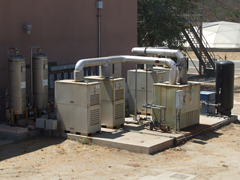Sustainable Water Infrastructure Contacts
Pacific Southwest, Region 9
Serving: Arizona, California, Hawaii, Nevada, Pacific Islands, Tribal Nations
Chiquita Waste Water Reclamation Plant
| Sustainable Water Infrastructure Quick Finder | ||||
|---|---|---|---|---|
| FundingGreen Jobs in the Water SectorLow Impact Development | Waste To Biogas Mapping ToolWater Conservation/EfficiencyWater-Energy Connection | Water Loss ControlWhy Sustainability? | ||
What a Gas!

In 2002, the Santa Margarita Water District initiated a renewable energy project at the Chiquita Waste Water Reclamation Plant. The Chiquita plant installed four 30kW Capstone microturbines that use about 105,000 cubic feet of digester gas a day to produce, on average, 2,500 kW a day. Before installing the microturbines, Chiquita flared the digester gas. Now, it’s a free fuel for the microturbines, the exhaust of which is so hot that it is captured and used to heat the digester tanks to above 100 degrees Fahrenheit, reducing the need for heat generated by boilers. The four microturbines provide 10-15% of Chiquita’s power needs.
Check out the EPA’s Combined Heat and Power Partnership catalog to learn more about microturbines and other CHP technologies.
No Sweat
The key to Chiquita’s success is keeping water out of the units. Their digester gas system moves low-BTU, high-moisture gas into a large storage sphere where much of the water drop-out takes place while maintaining the gas at higher pressures for the boilers and microturbines. Additionally, a desiccant tower (D-20), a few coalescent filters, and a refrigerated dryer further remove moisture. As part of the project, Chiquita installed siloxane towers to remove siloxane, which, if deposited on pistons and cylinder heads, is extremely abrasive and damages the engine. To protect air quality, a stainless steel filter and two cartridge filters were also installed to remove particulate matter.
Show Me the Money
With a $77,400 rebate from the South Coast Air Quality Management District, a $92,369 rebate from the San Diego Regional Energy Office, much as $8000 in monthly energy savings and as, the $372,937 invested in the project was paid back in just 2.5 years.
What Does the Future Hold?
The Chiquita plant is looking to double their electricity generation within the next few years by purchasing larger microturbines. They hope to use the additional waste heat to dry biosolids before they’re trucked out, which would result in lighter loads and less diesel.
